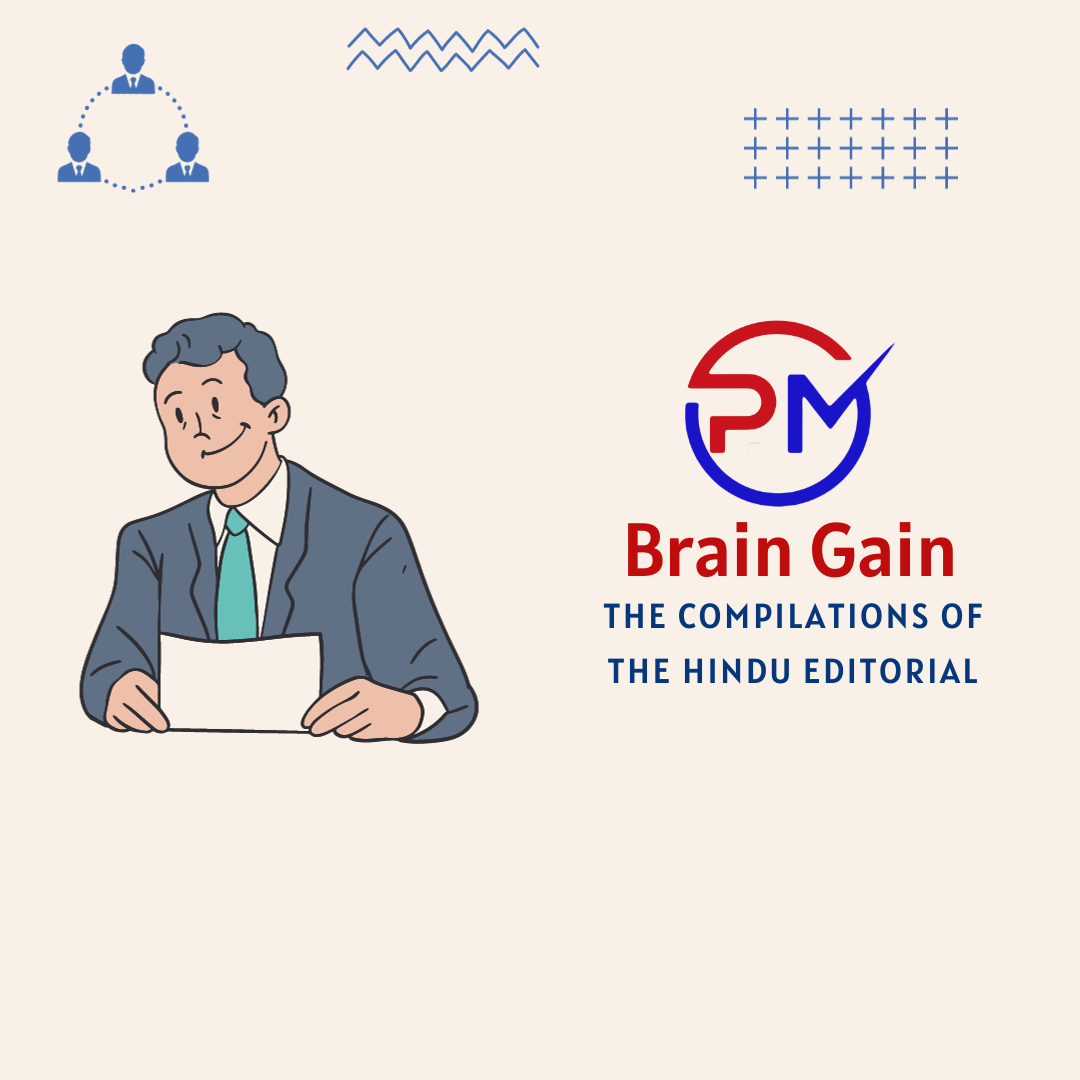Editorial 1 : India, disability inclusion and the power of ‘by’
Context: The inclusion of persons with disabilities into the economy can help boost global GDP between 3% to 7%.
Introduction
- Globally, 1.3 billion people (which is equivalent to nearly the entire population of India) live with some form of disability. Of them, 80% live in developing countries; further, 70% of them live in rural areas.
- Current systems are designed for persons without disabilities and end up being exclusionary to people with disabilities, resulting in them experiencing higher instances of poverty, lack of access to education and opportunities, informality, and other forms of social and economic discrimination.
| DisabilityA disability is any condition of the body or mind (impairment) that makes it more difficult for the person with the condition to do certain activities (activity limitation) and interact with the world around them (participation restrictions).Disability results from the interaction between individuals with a health condition, such as cerebral palsy, Down syndrome, and depression, with personal and environmental factors including negative attitudes, inaccessible transportation and public buildings, and limited social support.Disability as an identity and entity exists at the intersection of multiple vulnerabilities — social, economic and gender — with each facet requiring careful consideration when conceptualising action for equity. |
‘For and By’
- According to the English dictionary, “For” is often used when a person is receiving something and “By” is to “identify the agent performing an action”. This difference is crucial when it comes to disability inclusion, as the approach is completely different if it is “by” persons with disabilities being a part of the process and not “for” them, without them in the process.
A case for inclusion
- At the outset, the inclusion of persons with disabilities into the economy can help boost global GDP between 3% to 7%, as per the study by the International Labour Organization (ILO), “The price of exclusion: The economic consequences of excluding people with disabilities from the world of work”.
- We believe that everyone has the right to equal treatment and opportunities at work, agnostic of any attributes other than the ability to do the job. The reality, however, is mixed. The current employment scenario is limited, providing fewer jobs for persons with disabilities and perpetuating stereotypes that create further barriers for people with disabilities to access the labour market.
- It is also in direct contravention of the United Nations Convention on the Rights of Persons with Disabilities, which advocates changing attitudes and perceptions towards persons with disabilities and viewing inclusion from a social development dimension. Disability inclusion is rooted in assuring the rights of persons with disabilities and recognising the economic benefits of inclusion.
Challenges in rural areas
- In India, the Central and State governments have various schemes for persons with disabilities and a unique id for persons with disabilities (UDID) card, established as part of the Rights of Persons with Disabilities Act (2016).
- The first step is awareness to ensure last-mile connectivity of the benefits enumerated for people with disabilities by the government, which begins with the capacity-building of community leaders who can advocate for this at the grass-roots level.
- This is especially important in rural areas, where persons with disabilities tend to face greater challenges when compared to their urban counterparts, with even more limited access to education and employment. Some developmental schemes, too, exclude them.
- They are viewed as objects of charity and not as persons with agency with an ability to participate in decision-making processes.
- Rural areas also have high agricultural dependence and face the heightened risk of climate calamities arising from rising sea levels, reduced access to clean water and food, hurricanes, heatwaves, and floods, with rural people at the frontlines of these challenges.
- A bottom-up approach to disability inclusion is crucial to build productive pathways out of poverty and ensure that persons with disabilities are recognised as active members of society and the economy.
- The private sector holds a key in promoting the employment of persons with disabilities. In addition to a robust legal framework, experience shows the importance of engaging the private sector and building the confidence of companies to hire and retain workers with disabilities.
- Additionally, engagement of employers’ federations, including those representing small and medium-sized enterprises, as well as with trade unions, has shown to have great potential to promote the employment of persons with disabilities.
The SPARK project.
- The ILO and the International Fund for Agricultural Development (IFAD), in collaboration with the Women’s Development Corporation in Maharashtra, are implementing the Sparking Disability Inclusive Rural Transformation (SPARK) project.
- Through this project, persons with disabilities were put in the lead, being identified from the villages, and trained as Disability Inclusion Facilitators (DIFs). The DIFs engage with the community, persons with disabilities, caregivers of persons with disabilities, women from self-help groups and other stakeholders to raise awareness about disability inclusion and barriers to inclusion.
- The DIFs identify women with disabilities and mainstream them in existing self-help groups for social and economic development, where these women have been able to access funds to start an enterprise. The SPARK project has been able to bring an attitudinal shift towards persons with disabilities, right from the societal to administrative levels.
Conclusion
- The goal of social justice cannot be achieved without the inclusion of persons with disabilities in all spheres of development, starting with rural areas and rural resilience.
- Evidence shows a bi-directional link to poverty, nutrition, and hunger, and as a consequence, there needs to be more inclusive opportunities and employment in rural areas.
- Given the historic marginalisation of persons with disabilities and the backsliding of the progress on the Sustainable Development Goals, a fundamental shift in commitment, solidarity, financing, and action is critical. It is about time that the voices and needs of persons with disabilities be prioritised at the centre of the global development agenda.
Editorial 2 : Governors and Their Constitutional Remit
Context: The Supreme Court has recently ruled that a governor cannot unreasonably delay or refuse to ratify a bill passed by a state legislature, highlighting the fact that doing so compromises the legitimacy of elected officials and the legislative process.
Introduction
- The 27-page judgment in the State of Punjab v Principal Secretary to the Governor of Punjab and Another ruled that the governor, who is chosen by the President, only acts as a symbolic head and cannot indefinitely withhold action on bills.
- The Supreme Court’s decision has clarified that should the governor choose not to sign a bill, they must send the bill back to the legislature, along with a statement outlining their reasons for not accepting it.
- This ruling becomes even more significant in the context of the recent disputes between governors and elected governments in several states. Telangana, Tamil Nadu, Kerala, and Punjab have all petitioned the Supreme Court to request orders concerning their individual governors.
Clarification of Article 200 of the Constitution
- The main point of contention in this case was that the Punjab governor had detained four bills that were passed by the Punjab legislative assembly in June 2023. The ruling offers a definitive clarification of Article 200 of the Constitution, which deals with “Assent to Bills” in the states.
- According to Article 200, after a bill has been approved by the legislative assembly, or by both houses in a bicameral legislature, it shall be sent to the governor.
- There are three choices available to the governor when a bill is presented to them. The governor can declare:
- his assent to the bill;
- his withholding of assent; or
- his reserving of the bill for the President’s consideration.
- The Supreme Court judgment heavily emphasised the words “shall declare” and “as soon as possible” in Article 200 to suggest that the governor cannot indefinitely keep the bills pending without any action whatsoever.
Two major takeaways from the Judgment
- The ruling unambiguously affirms that the governor, as a constitutional but unelected authority, does not have the right to virtually veto the functioning of an elected legislature. The constitutional powers of the governor to grant their assent to the bills passed by the legislature must operate in such a way that they do not obstruct the “normal course of lawmaking.” According to the Supreme Court, indefinitely withholding assent amounts to a violation of the “fundamental principles of a constitutional democracy based on a Parliamentary pattern of governance.”
- The judgment also cited S R Bommai v Union of India to emphasise that the constitutional powers of the governor cannot disregard the principles of federalism, which forms a part of the basic structure of the Constitution. In the course of India’s legal–political history, one has seen umpteen instances where the position of the governor has been misused for furthering the dominance of the union government over state governments ruled by opposition parties. The many disputes between governors and select state governments in contemporary India also bear witness to this contestation between different political parties.
Not only a legal dispute
- Thus, it is not merely a legal dispute between the governor and the union government on the one hand, and certain state governments, on the other. It is also a political dispute between different ruling and opposition parties.
- In effect, the Supreme Court ruling in this case has pointed towards the dangers posed by such political disputes to the constitutional cause of federalism in India.
- Although the constitutional concept of a federal polity with a power-balance favouring the union was an institutional arrangement, the majority of federal disputes observed in recent times are not indicative of institutional misalignment but are rather instances of party dominance.
Conclusion
- The position of the governor is subject to what this Supreme Court judgment terms as “the tuning fork of democracy and federalism.” Through this judgment, the Court has sought to reaffirm the dignity and composure required for fulfilling the constitutional obligations expected from governors. More importantly, it carries a strict warning against the partisan misuse of the post of the governor in contemporary India.


